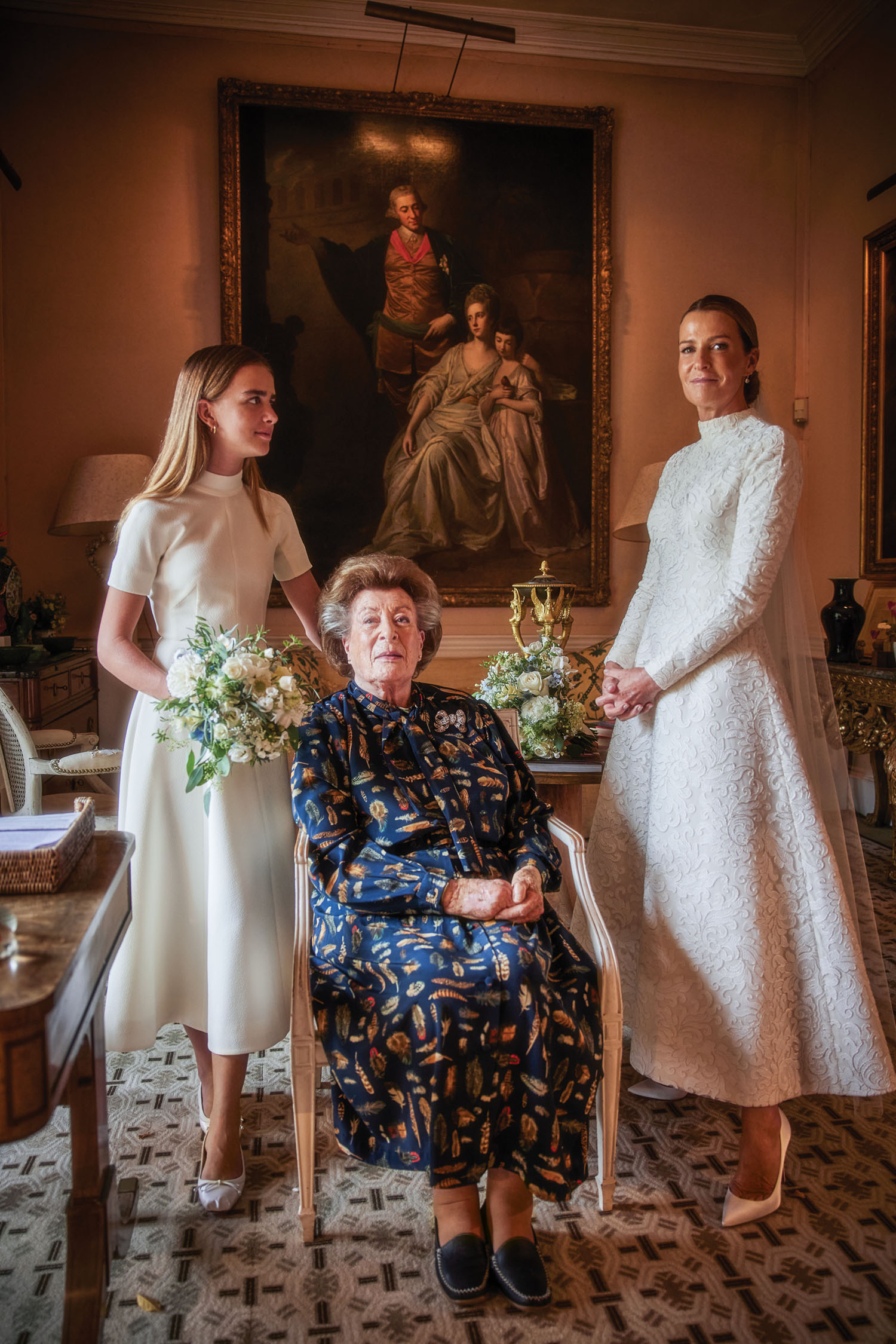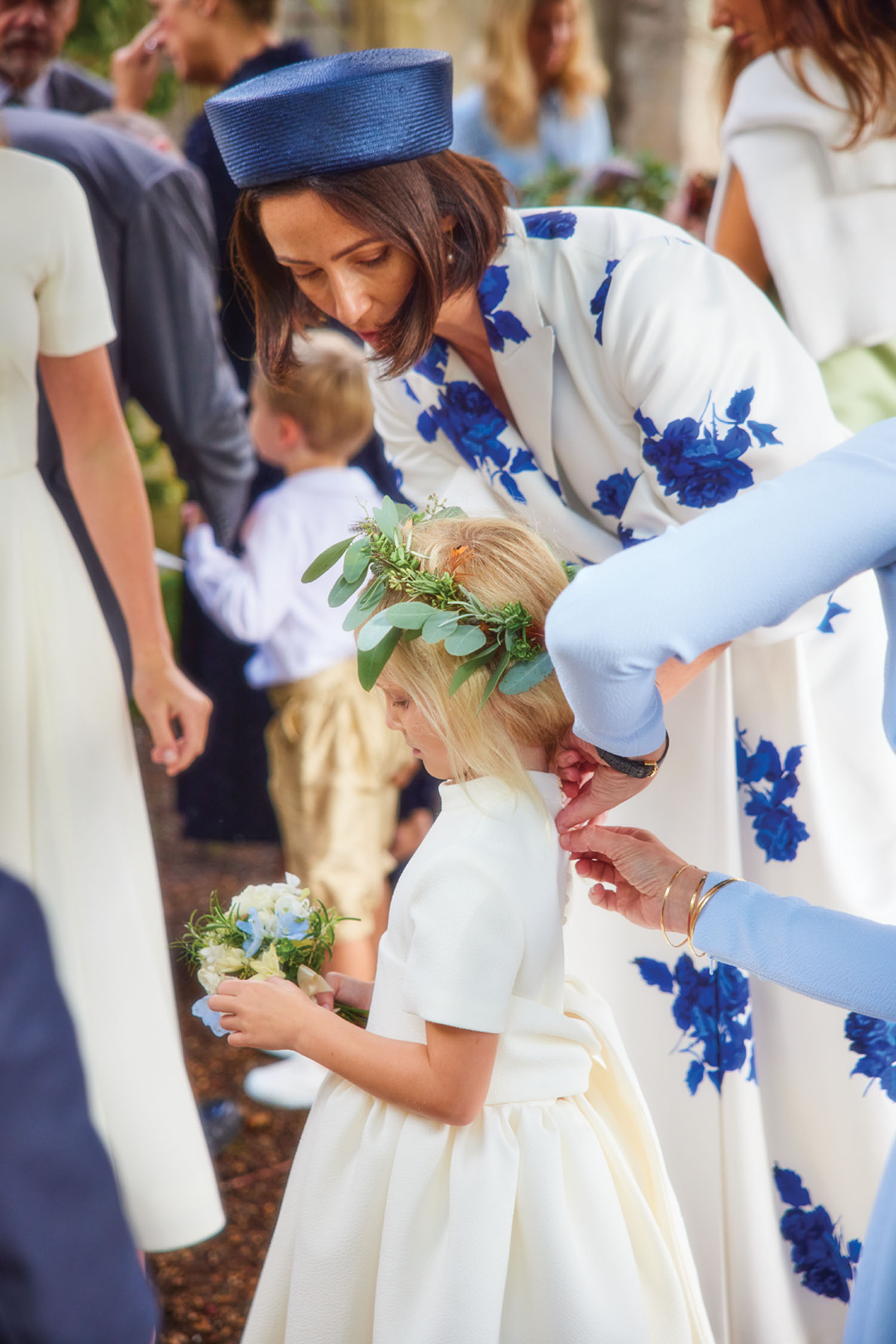
Photo by David Loftus
The traditional tossing of the bouquet took place just before the newly married couple left in their tobacco-brown, vintage Mercedes convertible.
Known for her work as a lifestyle entrepreneur and philanthropic activist, India Hicks is the granddaughter of Lord Mountbatten; the daughter of the late design icon David Hicks and his bride, Lady Pamela; and the godchild of Prince Charles. In pondering their wedding, India and her partner, David Flint Wood, arrived at a clear and soulful mission statement.
“After 15 months of lockdown, with the world upside-down and a future that looks rather turbulent, particularly for my kids who are between the ages of 13 and 24, I wanted to do something very grounding, something very anchoring, something that would feel completely normal and traditional and safe and secure,” she says. “Standing as a family in church and making some lifelong vows seemed the right answer.”

Photo by David Loftus
The couple were married in the nave of St. Bartholemew’s, the 14th-century church where India had been christened and where her father, famed British designer David Hicks, is buried.
India and David envisioned an unfussy affair that would be driven primarily by family considerations. The wedding party included their daughter, Domino, as the chief bridesmaid, along with Christian Louboutin’s twin girls and Inès de Givenchy (great-niece of the legendary designer) as bridesmaids. Dressed in gold bloomers, two towheaded young cousins, Fraser Flint Wood and Kit Fraser, served as page boys.

Photo by David Loftus
Three generations—India’s daughter and chief bridesmaid, Domino; India’s mother, Lady Pamela Hicks; and India—gather before the ceremony for formal portraits.

Photo by David Loftus
India’s good friend Zöe de Givenchy, mother of one of the bridesmaids, does a last-minute wardrobe inspection before the ceremony.
Finding a wedding date suitable for all the players proved quite complex. The puzzle involved Lady Pamela being in fine enough form for a sprightly stroll along the stone steps leading to the church, a COVID-friendly window for David’s brother Fred to cross the pond from New York, and the ability of all other key friends and family members to navigate the restrictions of the day. But the puzzle was solved, and the festivities unfurled.
Describing the inherent unconventionality of it all, India says, “We did everything backwards, even hosting a seated dinner party with toasting and dancing the night before the wedding. It was more like a reception.”

Photo by David Loftus
A prenuptial dinner dance in the field adjacent to the couple’s Oxfordshire house, America Farm, set a celebratory tone for the festivities.
The prenuptial fête was set in a clearing surrounded by wild grasses in a field near India and David’s Oxfordshire home, America Farm. Guests were seated at one long table, surrounded by the glow of torches and candles in clear-glass hurricane lanterns. Simple, rustic floral décor included a table runner, hanging installations, and garland along the center of the tent’s ceiling, all of which were composed of white roses, hydrangeas, and cosmos woven through lush foraged greenery, with some of the blooms coming from her mother’s nearby garden.

Photo by David Loftus
The night before the wedding, India and David welcomed guests for dinner and dancing. One of India’s hosting trademarks is a long, narrow banquet table (which makes for easier conversation) with understated, tailored motifs, such as the hurricane cylinders and candles interspersed among the lush greenery of the table runner.

Photo by David Loftus
Juliet Bennett of Babylon Flowers, a local and environmentally thoughtful floral designer, foraged greenery and sourced flowers locally for the table and hanging installation. Plant materials for the lush, naturalistic installation included magnolia foliage, hydrangeas, garden roses, and hops.
The bride-to-be asked designer and dear friend Naeem Khan to create a dress for the soirée, and he fashioned an exquisite mermaid-style gown. “There is much history involved in this wedding,” says the designer as he reflects on the occasion. “India is the granddaughter of Lord Mountbatten, who at the stroke of midnight on a date in 1947 gave the country of India to its people—a long-awaited freedom. Now, years later, India herself wears a dress made in India, by an Indian designer, with an Indian motif.”
For the wedding ceremony, the couple chose the local St. Bartholomew’s in Brightwell Baldwin, a charming 14th-century country church that boasts special bookmarks through the pages of India’s family history. India was christened there, and it is the place where her father is buried. In another homage to family and tradition, Pulbrook & Gould, the legendary London floral and wedding powerhouse that conceived Lady Pamela’s wedding bouquet decades ago, created India’s bridal bouquet, as well as those of the bridesmaids. As her sensibility encompasses a thoughtfully sustainable approach, India made a conscious effort to involve as much local talent as possible, including flower farmer and designer Juliet Bennett of Babylon Flowers, who decorated the church and reception site.

A vintage photo of Lady Pamela’s wedding to interior designer David Hicks includes her bouquet of lilies of the valley from Pulbrook & Gould, the same London floral firm that conceived India’s wedding bouquets.

Photo by David Loftus
India’s wedding bouquet, created by Pulbrook & Gould, included roses (‘Iceberg,’ ‘Winchester Cathedral,’ and ‘Susan’), phlox, Japanese anemones, rosemary, lavender foliage, tuberose, hydrangeas, lisianthus, love-in-a-mist, eucalyptus, abelia, and clematis.
For her wedding attire, the bride partnered with famed British fashion designer Emilia Wickstead to bring to life her vision of a dress that would differ from a classical wedding gown. India describes it as “cream French lace, not long, tea length with a slightly high neck—a hint of Grace Kelly.” Her close friend Christian Louboutin provided the perfect cream-colored high heels. “They were so comfortable. I never once wished I’d been in flip-flops,” she quips.
The service itself was timeless, including Church of England liturgy with lovely personal touches: One of the couple’s sons, Conrad, read the poem “I cannot tell you” by Morgan Harper Nichols; three of the couple’s favorite hymns were sung by the congregation; a version of the 23rd Psalm, handwritten by David, was read by his best friend, Charles Finch; and a soloist sang “Ave Maria” as the newly married couple added their names to the registry.

Photo by David Loftus
The celebration continued across the lane from the church at the Lord Nelson Pub, where guests congregated before the luncheon.
Rather than throw the expected lavish affair after the ceremony, India and David invited the wedding party and guests to stroll across the lane to the neighborhood public house, the Lord Nelson. Guests enjoyed a luncheon under a marquee filled with antique concrete planters and footed urns spilling over with local blooms and greenery. And in another nod to responsible, green living, flowers recycled from the night before graced the tables.
After the blur of revelry, surrounded by loved ones and the beauty of the familiar landscape, and with all boxes ticked, including the tossing of the bouquet, India and David departed in his vintage tobacco-colored Mercedes convertible to begin their married life and honeymoon weekend with all five of their children in “England’s green and pleasant land.”*
MORE FROM INDIA HICKS’S WEDDING ALBUM
Click image to enlarge.
Wedding Party Flowers
Abelia | Borage |Eryngium | Eucalyptus | Hebe |Hydrangeas | Japanese anemones | Jasmine | Lavender foliage | Lisianthus | Love-in-a-mist (nigella) | Old man’s beard (clematis) |Phlox | Rosemary | ‘Iceberg,’ ‘Winchester Cathedral,’ and ‘Susan’ roses | Scabiosa | Tuberose

Photo by David Loftus
The family and wedding party assembled for group photos under the church’s arch, which was adorned with a garland of locally sourced greenery and flowers, including roses from Lady Pamela’s own nearby gardens. The informal yet elegant design of the garland was a beautiful embodiment of India’s ethos and style.

Photo by David Loftus
His and hers pens were custom-made by Yard-O-Led for the bride and groom to use when signing the wedding registry. India wore her mother’s brooch that Lady Pamela had inherited from her own mother. To avoid interrupting the neckline of her dress, India opted for the brooch to be pinned to the back of the dress, which she says would have been fine except “my low chignon kept catching on it, and by the time we got into the car to drive away, I looked like I had been dragged through a bush backwards.”
Church Arch Flowers
Beech, magnolia, and oak foliage | Cosmos | Dahlias | Hydrangeas | Miscanthus grass | Phlox | Roses from Lady Pamela’s rose garden | Sedums | Snapdragons | Zebra grass
Flowers for Dinner Party at America Farm and Wedding Luncheon at Lord Nelson Pub
Asparagus ferns | Birch | Cosmos | Eucalyptus | Hops | ‘Annabelle’ and ‘Limelight’ hydrangeas | Ivy | Magnolia and oak foliage | ‘Margaret Merril’ rose | Snowberry | Zebra grass
By Margot Shaw
This story appears in FLOWER magazine’s January/February 2022 issue.













